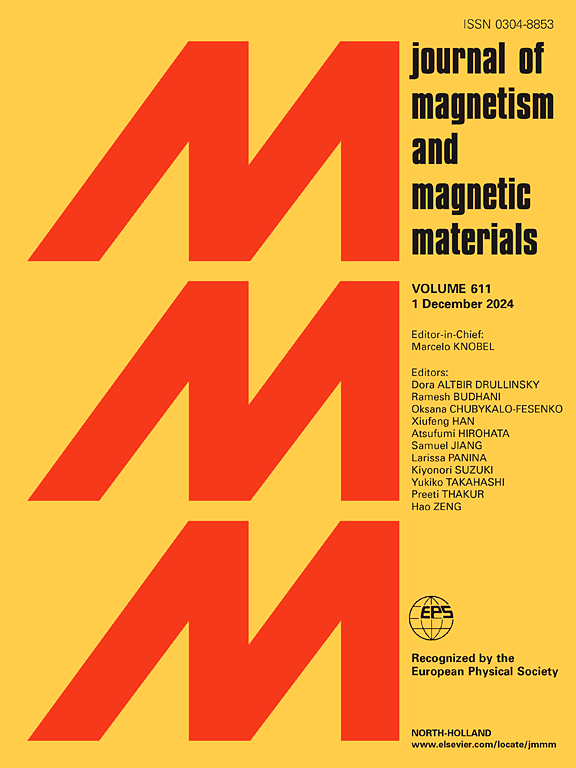Spin disorder state in a site-depleted 3D coupled trillium spin-lattice system Pb1.5Fe2(PO4)3
IF 2.5
3区 材料科学
Q3 MATERIALS SCIENCE, MULTIDISCIPLINARY
引用次数: 0
Abstract
The study of spin liquids has emerged as a prominent subject of investigation in the field of magnetism owing to their notable characteristics encompassing long-range entanglement, fractional excitations, and topological order. The spin-liquid state is an exotic state of matter with no conventional magnetic long-range order and is rarely observed in S = systems. Here, we have studied the magnetic behavior of Pb1.5Fe2(PO4)3 (PbFPO) through magnetic and heat capacity measurements on polycrystalline samples. The PbFPO compound has two Pb sites with 25% site depletion in the lattice structure. The compound holds two trillium lattices of S = moments in the unit cell, which are connected with additional magnetic couplings similar to that of KSrFe2(PO4)3. Despite the comparatively large Curie–Weiss temperature of -68 K (antiferromagnetic), the magnetic susceptibility data shows no sign of magnetic long-range order down to 2 K. The absence of field-dependent behavior in the heat capacity data up to 110 kOe field indicates that the PbFPO system possesses elevated spin correlations. The magnetic heat capacity data follows the power law behavior, probably stemming from the system’s gapless excitations from the spin-disordered state. Although the compound has a heavy site depletion, the spin disorder state is quite robust and is not even affected by the large magnetic fields.
缺位三维耦合万亿元自旋晶格体系Pb1.5Fe2(PO4)3的自旋无序态
自旋液体由于其显著的特征,包括远程纠缠、分数激发和拓扑有序,已成为磁学领域的一个重要研究课题。自旋液态是一种奇异的物质状态,没有传统的磁长程序,在S = 52系统中很少观察到。本文通过对Pb1.5Fe2(PO4)3 (PbFPO)多晶样品的磁性和热容测量,研究了Pb1.5Fe2(PO4)3 (PbFPO)的磁性行为。该pbpo化合物在晶格结构中有两个Pb位,且损耗为25%。该化合物在单晶胞中拥有两个S = 52矩的万亿晶格,这些晶格与KSrFe2(PO4)3类似的附加磁耦合连接。尽管居里-魏斯温度相对较高,为-68 K(反铁磁),但磁化率数据显示,在2 K以下没有磁性长程有序的迹象。在110koe场的热容数据中不存在场相关行为,表明pbpo体系具有较高的自旋相关性。磁热容数据遵循幂律行为,可能源于系统自旋无序状态的无间隙激励。虽然该化合物具有较重的位耗竭,但自旋无序态相当稳健,甚至不受大磁场的影响。
本文章由计算机程序翻译,如有差异,请以英文原文为准。
求助全文
约1分钟内获得全文
求助全文
来源期刊

Journal of Magnetism and Magnetic Materials
物理-材料科学:综合
CiteScore
5.30
自引率
11.10%
发文量
1149
审稿时长
59 days
期刊介绍:
The Journal of Magnetism and Magnetic Materials provides an important forum for the disclosure and discussion of original contributions covering the whole spectrum of topics, from basic magnetism to the technology and applications of magnetic materials. The journal encourages greater interaction between the basic and applied sub-disciplines of magnetism with comprehensive review articles, in addition to full-length contributions. In addition, other categories of contributions are welcome, including Critical Focused issues, Current Perspectives and Outreach to the General Public.
Main Categories:
Full-length articles:
Technically original research documents that report results of value to the communities that comprise the journal audience. The link between chemical, structural and microstructural properties on the one hand and magnetic properties on the other hand are encouraged.
In addition to general topics covering all areas of magnetism and magnetic materials, the full-length articles also include three sub-sections, focusing on Nanomagnetism, Spintronics and Applications.
The sub-section on Nanomagnetism contains articles on magnetic nanoparticles, nanowires, thin films, 2D materials and other nanoscale magnetic materials and their applications.
The sub-section on Spintronics contains articles on magnetoresistance, magnetoimpedance, magneto-optical phenomena, Micro-Electro-Mechanical Systems (MEMS), and other topics related to spin current control and magneto-transport phenomena. The sub-section on Applications display papers that focus on applications of magnetic materials. The applications need to show a connection to magnetism.
Review articles:
Review articles organize, clarify, and summarize existing major works in the areas covered by the Journal and provide comprehensive citations to the full spectrum of relevant literature.
 求助内容:
求助内容: 应助结果提醒方式:
应助结果提醒方式:


